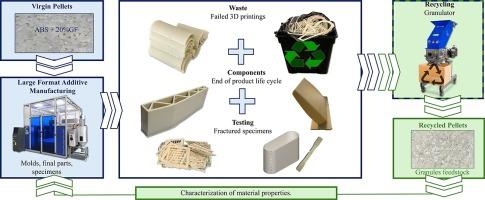再生ABS-GF在大幅面增材制造中提高印刷结构机械性能的研究与表征
IF 7.9
2区 材料科学
Q1 MATERIALS SCIENCE, MULTIDISCIPLINARY
引用次数: 0
摘要
大幅面增材制造(LFAM)已经证明了其为竞争市场生产高性能组件的能力。通过只在需要的地方存放材料,它大大减少了废物和能源的使用,获得了可持续性优势,并在更大规模上进一步增强。然而,更深入地了解材料回收对于实现可持续发展的下一个里程碑至关重要。在这项工作中,提出了一种方法,使用模具和最终部件,用短玻璃纤维(ABS-GF)增强的丙烯腈-丁二烯-苯乙烯制造,已达到使用寿命终点作为原料。观察到,循环使用使纤维长度减少了47.3%,这直接影响了纵向印刷方向的力学性能,导致最大拉伸应力降低了9%左右。然而,在印刷的横向上,这一降幅降至5.1%,在某些情况下,由于层间附着力的改善,回收材料甚至超过了原始材料。对附着力的分析表明,在回收过程中获得的较短的单体链可以更好地在层之间交错。这些结果表明,模具的重复使用是可行的,通过调整打印参数,我们可以获得适合要求应用的性能。本文章由计算机程序翻译,如有差异,请以英文原文为准。

Study and characterization of recycled ABS-GF in large format additive manufacturing to enhance mechanical properties of printed structures
Large format additive manufacturing (LFAM) has proven its ability to produce high-performance components for competitive markets. By depositing material only where it's needed, it drastically reduces waste material and energy use, obtaining a sustainability advantage that is further enhanced on larger scale. However, a deeper understanding of material recycling is critical to achieving the next milestone in sustainability. In this work, a methodology was proposed that uses both molds and final parts, manufactured in acrylonitrile-butadiene-styrene reinforced with short glass fibers (ABS-GF), which had reached the end of their useful life to be used as feedstock. It is observed that recycling reduces fiber length by 47.3%, which directly impacts the mechanical properties in the longitudinal printing direction, resulting in around a 9% decrease in maximum tensile stress. However, this reduction falls to 5.1% in the transverse direction to the printing, and in some cases, the recycled material even surpasses the virgin material due to improved interlayer adhesion. An analysis on the adhesion reveals that the shorter monomer chains obtained during recycling allow better interlacing between layers. These results suggest that the reuse of the molds is viable and by adjusting the printing parameters we can obtain properties suitable for demanding applications.
求助全文
通过发布文献求助,成功后即可免费获取论文全文。
去求助
来源期刊

Materials & Design
Engineering-Mechanical Engineering
CiteScore
14.30
自引率
7.10%
发文量
1028
审稿时长
85 days
期刊介绍:
Materials and Design is a multi-disciplinary journal that publishes original research reports, review articles, and express communications. The journal focuses on studying the structure and properties of inorganic and organic materials, advancements in synthesis, processing, characterization, and testing, the design of materials and engineering systems, and their applications in technology. It aims to bring together various aspects of materials science, engineering, physics, and chemistry.
The journal explores themes ranging from materials to design and aims to reveal the connections between natural and artificial materials, as well as experiment and modeling. Manuscripts submitted to Materials and Design should contain elements of discovery and surprise, as they often contribute new insights into the architecture and function of matter.
 求助内容:
求助内容: 应助结果提醒方式:
应助结果提醒方式:


